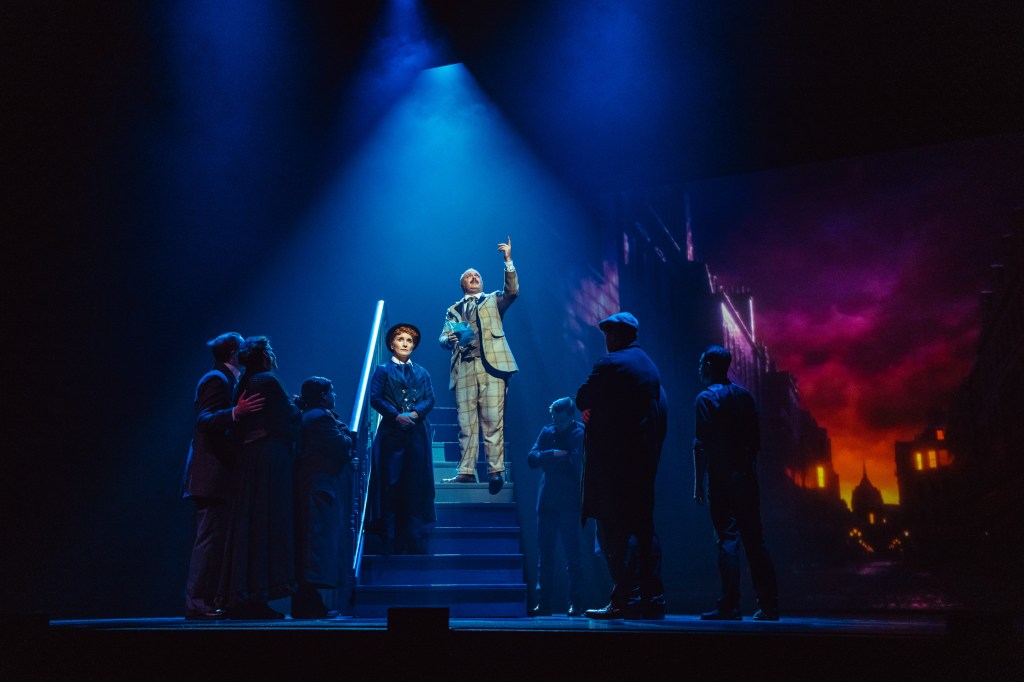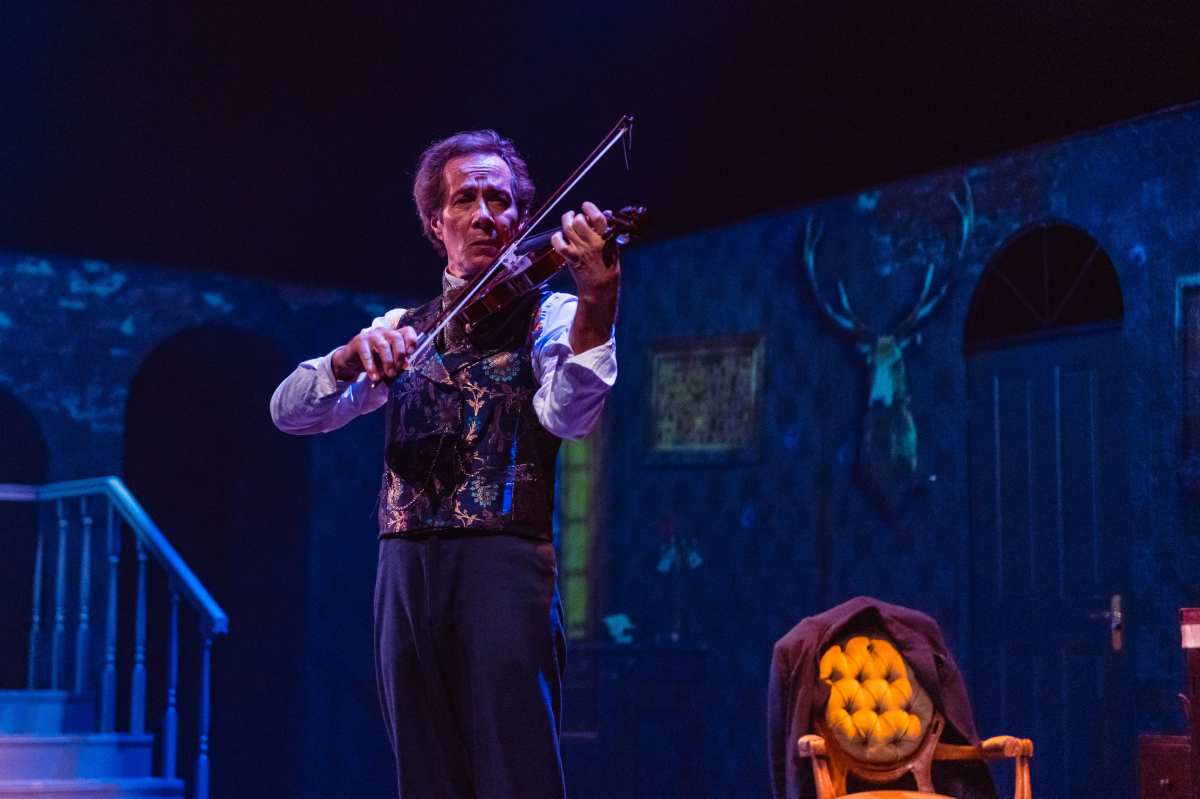The Mystery of the Valkyrie is yet another play born out of COVID lockdowns that should have had its world premiere season a year ago. Due to Brisbane floods the play was postponed and has finally come to the stage for a short season at Queensland Performing Art Centre (QPAC).
The brainchild of independent producer, Alex Woodward, The Mystery of the Valkyrie was commissioned from well-respected writer and director, Michael Futcher. The play analyses one of literature’s great mysteries, the thorny ‘final problem’ surrounding the death and return of Sherlock Holmes. The play is a melange of the truths we know from Conan Doyle’s novels about his famous sleuth, including most of his characters, as well as some literary fiction and a good chunk of theatrical licence.
Futcher decided to start with the famous Doyle ending at the Reichenbach Falls in Switzerland that caused much controversy, with readers unaware of what case Holmes was working on at the time of his supposed death. With open slather on the back story, Futcher created a new storyline that he based loosely on a missing toxic pathogen intertwined with a Germanic mythological theme of the Valkyrie. Making the character of Irene Adler into a Wagnerian opera singer, engaged to a scientist who had created the pathogen, neatly tied this together.
Futcher’s style of writing and use of language was truthful to Doyle and steeped in the melodramatic style of Victorian England and 19th century literary fiction. He was well assisted by dramaturg, Janis Balodis, who fleshed out the language dramatically, giving it a contemporary resonance accessible to a modern audience. There was also much wit and humour in the writing, with jokes centred on the characters as well as the theme of Germanic mythology.
The play was chock-full of fast action, short scenes with numerous set changes and some doubling of roles, which mostly worked seamlessly. As director, Futcher kept the action moving at a cracking pace, occasionally making the convoluted narrative tricky to follow. However, his fleshing out of individual characters and their idiosyncrasies was well managed, while he kept a firm control on proceedings.

In Doyle’s novels we never know if Holmes and his adversary Moriarty ever met on a one-to-one basis before the confrontation at the Reichenbach Falls. In The Mystery of the Valkyrie, the introduction of a few very important scenes between them added a serious and intellectual component to the story while strongly contrasting the philosophies of these two diametrically opposed characters. It was a very welcome twist.
Set and costume designer, Isabel Hudson, offered an enormous range of settings from Holmes’ house to a country estate, Victorian street scenes, railway stations and carriages, laboratories, the opera house and the Swiss Alps among others. With painted backcloths, enhanced by video projections, the scenic elements used a system of manually moveable trucks to depict locations and these worked smoothly. A cleverly designed and simple hansom cab was beautifully used. Moreover, her costumes were all of the period and well-suited to the characters.
The sets were imaginatively aided by some extraordinary visual imagery created by Craig Wilkinson. Using both back and front projections, he presented realistic street settings, backdrops of night scenes with moons and scudding clouds, a glowing stage setting for the Ring Cycle at Covent Garden plus terrific alpine scenes with running waterfalls and a quite mesmerising final scene.
Equally impressive were the scenes in railway carriages with visual imagery depicting a moving train that was then replicated as the backdrop to the moving hansom cab. A clever use of technology allowed Holmes’ words, thought processes and images to be projected across the scenery.
David Walters’ atmospheric lighting assisted by sharply defining the individual characters, as well as offering some lovely midnight blue imagery and many different daytime settings from drab London streets to bright alpine pastures. Phil Slade’s sound design, with sweeping sections of melodramatic music and extracts from Wagner’s Ring Cycle, was well placed, as was the use of radio mics for all the actors.
As Sherlock Holmes, Eugene Gilfedder was quite splendid. Coming over as a gruff, unemotional and deeply flawed character, Gilfedder still managed to invest Holmes with some humanity. His wry sense of humour and some good one-liners helped to round the troubled, drug-addicted but brilliant character out quite nicely.
As Doctor Watson, Anthony Gooley gave a well-crafted performance as the frustrated but intensely loyal foil to Holmes. He also acted as narrator, linking sections of the story together. Quite gullible and not very smart, Gooley’s portrayal gave us a warm and open-hearted Watson with some nicely-phrased comic lines.
Bryan Probets gave a steely, dark and evil performance as Moriarty and was excellent in his scenes with Holmes. Also, he was absolutely delicious as the manservant Ames to landowner, Jack Barker, re-enacting the supposed death of scientist, Daniel Bauman. Always good in every role he takes on, Probets’ over-the-top but hilarious portrayal of a confused and ageing servant was spot on.
Kimie Tsukakoshi made a strong and believable Irene Adler, the one woman in Doyle’s stories that Holmes cannot defeat. She is a fine actress and contributed greatly to the playing out of the narrative, and was also terrific miming to Brünnhilde’s aria in Die Walküre.
As the two erstwhile police characters, constantly being thwarted by Holmes, Helen Cassidy (Inspector Macdonald) and Danny Brown (Sergeant Turner) were played for laughs and had all the makings of Mack Sennett’s Keystone Cops. Both affected strong accents, Scottish and Cockney respectively, which were consistently well spoken and quite fun.
Read: Theatre review: Rhinestone Rex and Miss Monica, Ensemble Theatre
While the storyline had some holes with improbable aspects, this was a good, fun night out and very entertaining. It was well directed, well performed and with extremely good audiovisual elements that brought the stage to life. For a first independent theatre work from a new producer, this was certainly an impressive start.
The Mystery of the Valkyrie by Michael Futcher
Presented by Woodward Productions in Association with PowerArts
Queensland Performing Arts Centre
Writer/Director: Michael Futcher
Dramaturg: Janis Balodis
Set and Costume Designer: Isabel Hudson
Video Designer: Craig Wilkinson
Lighting Designer: David Walters
Sound Designer and Composer: Phil Slade
Movement Director: Dan Venz
Fight Director: Andy Fraser
Head of Wigs: Madi Jennings
Cast: Eugene Gilfedder, Anthony Gooley, Bryan Proberts, Kimie Tsukakoshi, Helen Cassidy, Darcy Brown, Jackson McGovern, Danny Brown, Rowan Chapman, Sarah McIntosh
The Mystery of the Valkyrie finished its run on 19 March 2023.





